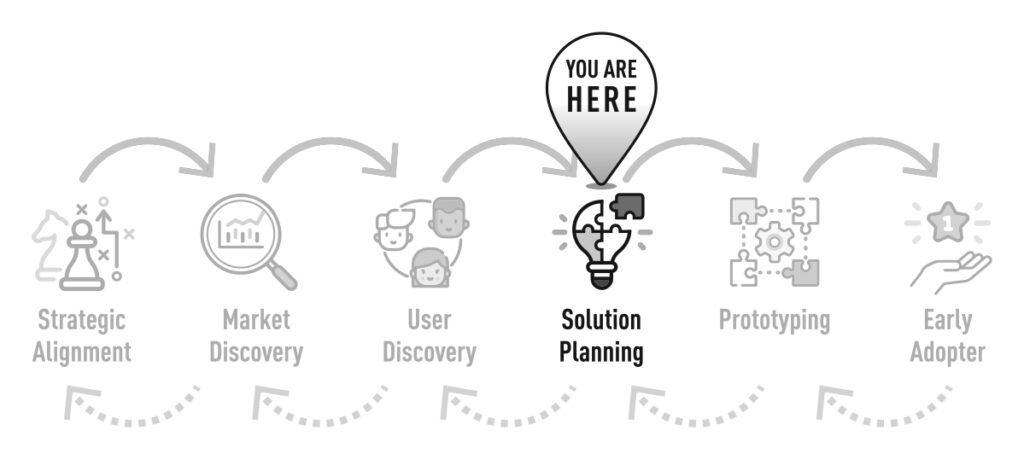
Artificial intelligence (AI) has come a long way. The technology advancements have been impressive, and they come at lightning speed these days. Today, Generative AI is taking the world by storm, with applications (and risks) appearing to be endless. There is a lot of fantastic technology and also a lot of hype.
Unfortunately, many companies latch onto the hype, and out of fear of missing out, they quickly switch to a technology-first approach.
I’ve had countless conversations with executives at companies large and small where they see AI as the holy grail. They might not fully understand AI’s benefits or value, but they can’t wait to get on the AI wagon.
Executives tell me things like, “We need an AI strategy” or “The focus of our next release needs to be AI.” Likewise, I see startups with an AI-centered pitch or websites where every other word seems to be AI.
But companies focusing on capitalizing on the next big trend usually head for a rude awakening. The reason is that AI is not a strategy. AI is just a tool, and therefore, it doesn’t have any benefits on its own. AI’s value comes from the potential benefits you could deliver to your customers by applying this technology to solve your customer’s pains.
In short, the key takeaway from this article is this: “Customers don’t buy AI. They buy a solution to a problem.”
Keep in mind that if you are building Enterprise Software or B2B IoT solutions, your customers don’t care how you solve their problems. They don’t care if you are using AI, ML, IoT, 5G, or Fairy Dust. As long as you deliver the desired outcome, the inner workings of your product are irrelevant to them.
Instead of trying to find a problem to solve with AI, spend time revisiting your customer’s biggest challenges and then discuss with your team if you could leverage AI to develop an innovative solution to that problem.
Related article: People don’t buy IoT. They buy a solution to a problem.
Where Does AI Fit in the B2B Innovation Journey?
Discussions on whether AI can deliver value to your customers should occur during the Solution Planning Stage of the innovation journey. According to the B2B Innovator’s Map, you are here:

From the diagram, notice that before going into the Solution Planning Stage to discuss whether AI is a good fit for your product, you must have a robust understanding of your customer’s pains. This understanding comes from completing the first three stages of the B2B Innovator’s Map: Strategic Alignment, Market Discovery, and User Discovery.
Suppose you suspect gaps in your customer understanding, including your desired target market, the critical pains of your Champion, or the critical challenges of your user ecosystem. In that case, you shouldn’t waste time discussing potential solutions and tools with your team.
In that case, you should go back to the early stages of the B2B Innovator’s Map and focus on gaining that deep customer understanding first. The better you understand your customer, the better solution you can create. Believe me, your team, your company, and your customers will thank you for it.
In the Solution Planning Stage, you will get together with your team to prioritize your top customer challenges and discuss potential solutions and implementation approaches. This is the time to discuss whether AI can provide a better/cheaper/faster solution to differentiate your product in the market.
During the Solution Planning Stage, you will also map your assumptions and create your Experiment Roadmap to test if your AI solutions effectively solve your customer’s pains.
Is AI the Right Choice for Your Product?
AI is a perfect tool for solving problems that involve “learning” how a complex system behaves.
In my podcast episode with Keith Strier, Head of AI for EY, he uses autonomous vehicles as an example to explain the power of AI. He mentioned that it’d be impossible to “program” an autonomous car. The number of variables and situations is too much for anybody to code.
Instead of programming all the variations, we use AI to “teach” the car how to drive. By training the car’s navigation and steering systems on real-world roads, the models learn what it takes to drive the vehicle without programming every variation.
Suppose your customer problem includes complex variables, terabytes of data to analyze, and situations where patterns are hard to find. In that case, your product might be an excellent candidate to leverage AI. Below, I share a few real-world examples to give you a better perspective.
Note: The technology behind AI is very complex. As a Product professional, you should focus on the business and customer benefits of applying AI rather than on how the technology works. That said, you will always gain brownie points with your Engineering team if you are familiar with how AI works. If you want to dive deeper into how AI works from a PM perspective, I recommend the courses from the AI Product Institute. My friend Adnan Boz does a great job breaking down these complex topics.
Real-World Examples of B2B Solutions Leveraging AI
Generative AI, including chatbots and image-generation applications, is getting the most attention today. However, there are a lot of different types of AI applications.
Now that you know where AI fits in the B2B innovation journey and whether AI is a good fit for your product, let’s dive into some real-world examples.
Supporting the Electric Grid through Batteries and AI
I used to work at Stem, an AI-powered Energy Storage company in Silicon Valley. Our main problem to solve was how to use a commercial battery to deliver cheap, reliable power to a building while at the same time selling any extra capacity to the Electric Grid.
The challenge was ensuring the battery had enough energy to power a building AND enough energy left to dispatch to the Grid as needed. As you can imagine, every building was unique because of its size and use, including office buildings, hospitals, gas stations, car washes, etc. Our model had to learn the individual behavior of each building so it could anticipate when to charge, when to discharge, and when to save energy for an upcoming Grid event.
The company’s software, Athena, is a perfect use case for AI. Writing unique rules for each building would have been impossible and impractical. Instead, through AI, the models can learn the nuances of each building and, therefore, can self-optimize to maximize performance.
By the way, given the complexity of the Energy industry, many Climate Tech companies are using AI effectively to create profitable solutions to many challenges in the Energy transition.
Some other examples include:
- Span – Leveraging AI to convert houses into intelligent Distributed Energy Resources
- Aurora – Leveraging AI to create high-resolution 3D models for installing rooftop solar panels
- Community Energy Labs – Leveraging AI to control HVAC systems in schools, keeping classrooms cool and saving cash
Next-generation Product Management tools
So far, I’ve used autonomous vehicles and intelligent energy storage as examples of AI solving customer problems. But not every AI application needs to be world-saving or world-changing. There are many excellent applications in many other industries building B2B products. A good example is ProdPad, a market-leading road-mapping application for Product teams.
ProdPad recently released a series of AI-powered features that automate many everyday PM tasks. These include automatically writing user stories and aligning your backlog with your company’s vision.
One of my favorite features is ProdPad’s ability to uncover themes from your customer feedback. This is a perfect application of AI since sifting through discovery interviews and user feedback can be tedious, laborious, and error-prone. Having the software sift through countless customer interviews and synthesize the insights is a true game changer.
The Bottom Line
The main takeaway is this: “Customers don’t buy AI. They buy a solution to a problem.” Don’t get distracted by the allure of AI or any other emerging technology. Focus on understanding your customer’s needs and then, only then, work with your team to explore if AI can be a powerful differentiator for your product.